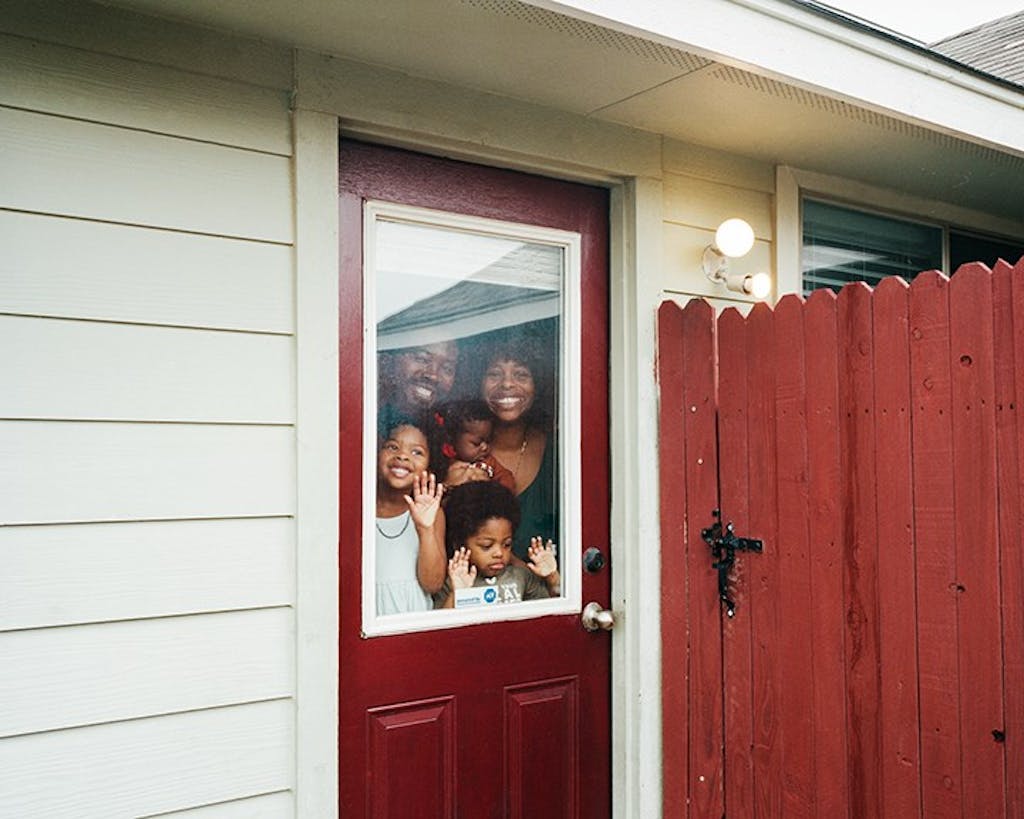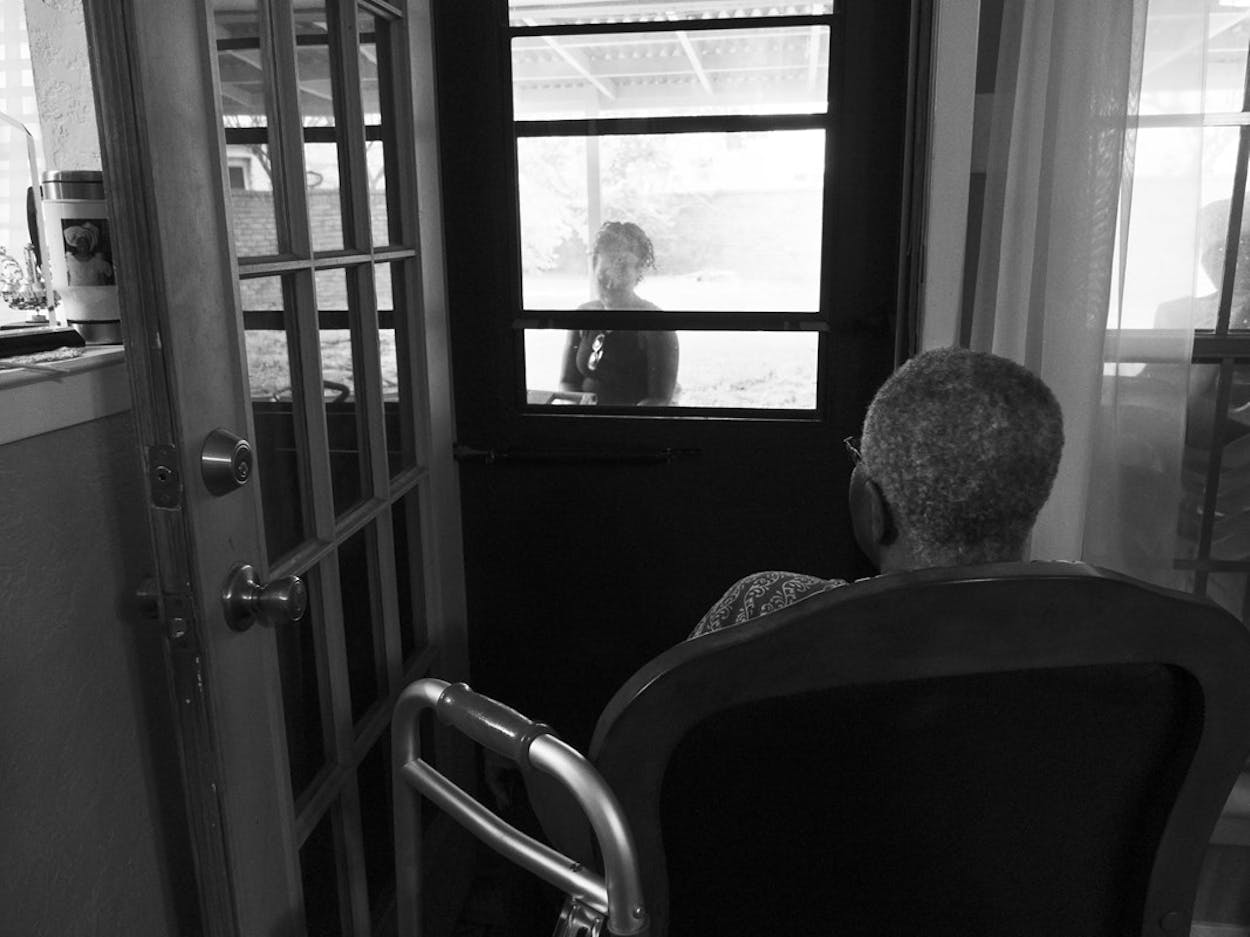In March, multidisciplinary artist Abieyuwa Eigbobo moved in with her grandparents in Arlington to help care for them during the pandemic. Her mother also moved in, putting three generations of the Nigerian American family under the same roof for the past five months. “We’ve been spending a lot of time together,” Eigbobo says. “They tell me old stories, and we’ve been listening to music from when they were younger.”
Eigbobo has been using her camera to document her family’s quarantine experience, and one of her images was selected for the Houston Center for Photography’s extraordinary new virtual exhibition “Togethering.” The exhibition comprises work by 173 photographers from fifteen countries, from China to Lithuania to Mexico, and represents an emotionally rich visual diary of everyday life during the COVID-19 pandemic. Eigbobo contributed a photograph she took on Mother’s Day, during a visit from her sister Odion, who works for a charter airline that was repatriating American citizens stranded abroad.
“She had just come back from Bulgaria, and she wanted to see my mom and grandma, but she couldn’t go in the house,” Eigbobo says. “We let her into the backyard, pulled up a chair for my grandmother, and they talked through the screen door.” Eigbobo stood behind her grandmother to take the monochrome photograph, capturing her perspective as she looks out the door. Next to her grandmother is a walker, a reminder of the fall she suffered earlier in the year. It’s an image of vulnerability and strength, isolation and connection.

Similar themes animate the exhibition’s other images, which were selected by Houston Center for Photography staff under the leadership of executive director and curator Ashlyn Davis. Founded in 1981 as an association of Houston-area photographers, the nonprofit now operates a modest gallery around the corner from the Menil Collection and offers year-round photography courses. Although the gallery has been closed to the public since March, the organization continues to offer online classes, which have attracted an increasingly international audience.
After putting out a call for entries in April, the center received more than three thousand submissions from both amateur and professional photographers around the world. “I wanted to see photos that my mom and dad might take—people who don’t necessarily call themselves photographers,” Davis says. “Some of those are the most interesting. There are a lot of portraits of neighbors taken through windows, photos of family members cutting each other’s hair—those intimate moments we’re confronted with in isolation.”


While the exhibition includes plenty of documentary-style images of daily life, it also features staged portraits, still lifes, abstract experimental photography, and even a few photographs taken with homemade cameras obscura, also called pinhole cameras. Queens photographer Neil Kramer photographed himself engaged in a mock wrestling match with his ex-wife, while his mother, dressed as a referee, pretends to officiate. Washington State native Candice Baker, who lives in Bahrain, captured a girl pinning an insignia on the uniform of her father, a naval commander on the U.S.S. Sentry.
Austin copywriter Meg Furey-Marquess found inspiration closer to home. At the beginning of the pandemic, she began taking long walks around her neighborhood in Cherrywood, east of I-35. “I needed to get out of the house in a way that was safe, so I just decided to take my camera and explore,” Furey-Marquess recalls. “The streets were so empty, but it was strangely comforting to know that everyone was at home doing their part to be safe.” In nearby Hyde Park, she photographed a two-story house with a large, hand-painted banner hanging outside that read “Rent Strike.”

The image was selected for the virtual exhibition—the first in which Furey-Marquess’s photography has been included. A renter herself, Furey-Marquess sympathized with the sentiment expressed by the sign. She was laid off from her job at a marketing agency early in the pandemic and still worries about how she’ll pay her own rent. “It was just so uncomfortable to me that people are at risk of losing their homes or being displaced at a time when your home is literally your last refuge against COVID,” she says.
Because the photographs in the exhibition were taken in the early months of the pandemic, they reflect a period when the crisis was still new and unfamiliar—and when hope remained that political and public health officials might come together to bring the virus under control. With nearly 750,000 people now dead worldwide, nearly a quarter of them in the United States, that hope has mostly vanished, making the exhibition seem like a relic of a more innocent world. “It was kind of this naive, hopeful time,” Davis says. “The pandemic has now become so politicized that it doesn’t feel like we’re all in this together anymore.”


The exhibition is also a reminder that, for all the inequities COVID-19 has brought into sharp relief, there remain some experiences everyone in the world has shared. Loneliness. Nostalgia for normal life. Appreciation for small pleasures. A new sense of our interdependence.
“I hope the show reminds people of this time when we were united around a common goal and a common fear,” Davis says. “That’s especially important in the U.S. right now, with an election coming up.”








